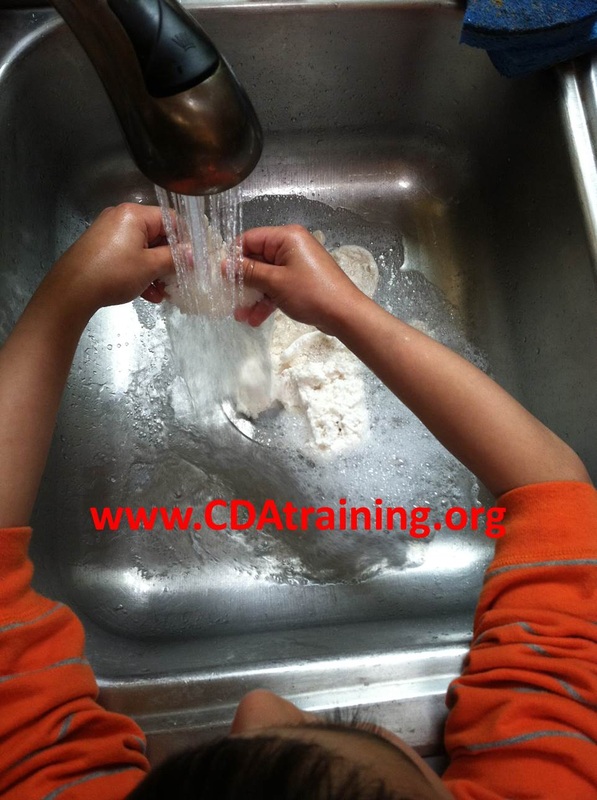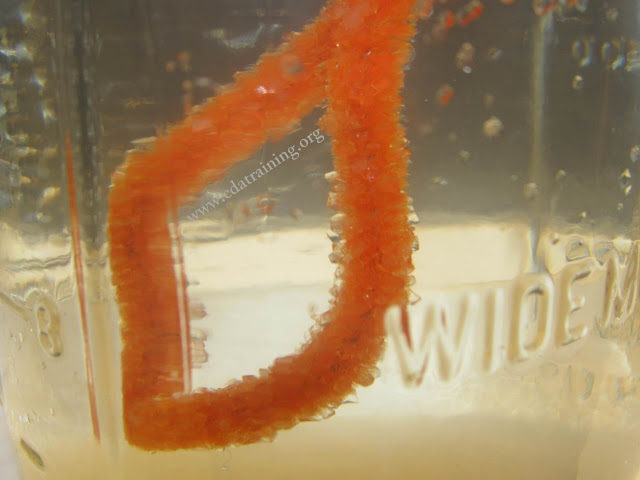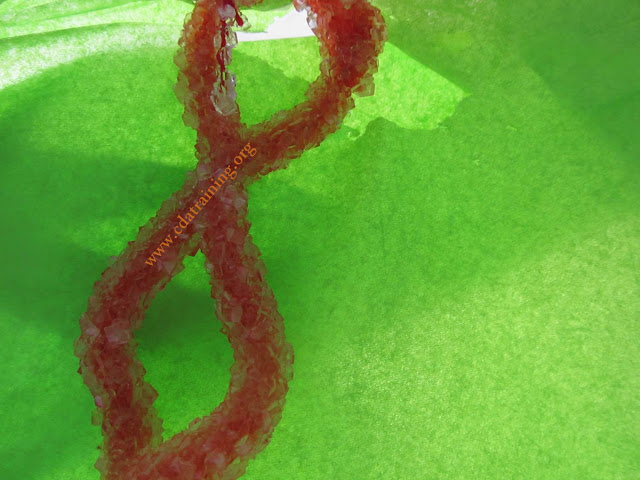*Warning* This project will make your home/Care Center smell like a bar of soap. Please use common sense when executing this project.Place a piece of waxed paper in your microwave, then place the bar of soap on top of the parchment. This really doesn't make a mess, so don’t worry. We started out with one minute, which gave us a good result. Had we known better, we would have stopped at one minute, but we decided to spring for two minutes and got burnt soap. As an FYI; Burnt soap makes a lot of soap smelling smoke...
**As a bonus sensory exorcise, we let the children play with their expanded soap n the sink. They really enjoyed feeling the different textures of the soap, and watching it melt away. 1. Go for a walk and collect sticks and leaves.
2. Glue the sticks and leaves onto poster board paper. (Your child can try to make it look like a tree, or any other design they would like). Good to know: Sticks and leaves with a flat surface work best. Here is what you will need: Borax, hot water, string, jar, pencil, and a pipe cleaner. 1. Have your child shape their pipe cleaner into whatever shape they want.
2. Put 1/2 cup Borax into the jar. 3. Pour 3 cups of boiling water into the jar with the Borax and mix until dissolved. 4. Tie the string onto the end of the pipe cleaner, and loop a pencil around the other end of the string and slowly lower into the jar (making sure that the pipe cleaner is not touching the bottom of the jar and is fully submerged into the water ). 5. Leave overnight......When you wake up in the morning go check on them and see how awesome they look!! 1. Draw an animal footprint on a paper plate then cut it out to create the stencil. 2. lay the plate flat on the ground and sprinkle flour over the stencil. 3. Slowly lift the stencil, and repeat the process until you have created the path you desire. Discuss which animals made the footprint. What is that animals habitat? What do they eat? Where did the tracks lead you? How does the animal affect you? How do you affect the animal? This activity can be modified to work for all ages. For younger children Identify the animals and their sounds. The older the child the more in depth you can go.
|
|
- Blog
- Online Child Care Courses
-
Seasonal Themes
-
Spring Themes
>
- Air and Space
- Arbor Day
- Birds
- Bunnies
- Cinco De Mayo
- Easter
- Eggs
- Farm
- Father's Day
- Fishing
- Flags of the World
- Flowers and Gardening
- Foster Care Awareness Resources
- Found Art
- Hot Air Balloon
- International Children's Book Day
- Insects
- Kid Friendly April Fools Pranks
- Mother's Day
- National Bed Month
- Rainbows
- Saint Patrick's Day
- Spring
- Sports
- Weather
- Women's History Month
- Worms
- Fall Themes >
- Summer Themes >
-
Winter Themes
>
- Advent
- Black History Month
- Cardiac Health
- Christmas >
- Chinese New Year
- Congenital Heart Defect Awareness Month
- Dental Heath Awareness
- Dr. Martin Luther King Jr. Day
- Dr. Seuss Birthday
- Elf on the Shelf Ideas
- Football - Super Bowl
- Germs and Illness
- Grinch
- Groundhog Day
- Hanukkah
- Hibernation
- Kwanzaa
- National Cookie Day
- New Years
- Olympic Games
- Penguin
- Pets
- Post Office
- Presidents Day
- Sensory
- Snow
- Snowman
- Teddy Bears
- Winter
- Valentines Day
- Valentines Day Cards
- Valentines Day Decorations
-
Spring Themes
>
- All About Babies
- Growing and Learning
- Contact Us
- Online Courses for Early Childhood Educators
We have provided links where books or educational items that are related to the lesson plan can be purchased on Amazon. These links are intended for the purpose of your convenience to find the referenced item. However, as an Amazon Associate we earn from qualifying purchases that result from clicking on the links.
This website is owned and managed by Successful Solutions Professional Development LLC. Links to online courses that can be purchased are services that are provided by Successful Solutions Training in Child Development, which is a subsidiary of Successful Solutions Professional Development LLC.
This website is owned and managed by Successful Solutions Professional Development LLC. Links to online courses that can be purchased are services that are provided by Successful Solutions Training in Child Development, which is a subsidiary of Successful Solutions Professional Development LLC.
We offer the most comprehensive student support available in a web based learning environment.
E-mail: [email protected]
Phone: (360) 602-0960
Phone: (360) 602-0960
123 Play-and-Learn! Child Care Basics Resources
A child care curriculum blog brought to you by Successful Solutions Training in Child Development.
A child care curriculum blog brought to you by Successful Solutions Training in Child Development.
Address: PO Box 727, Burley, WA 98322-0727 * www.123playandlearn.com
Copyright 2018. Successful Solutions Professional Development LLC. * All Rights Reserved. Updated June 27, 2018
Copyright 2018. Successful Solutions Professional Development LLC. * All Rights Reserved. Updated June 27, 2018





































 RSS Feed
RSS Feed
